Advertising by Google
The culinary of Bahia, Brazil
By Ericivaldo Veiga, doctor of Social Sciences from the Catholic University of São Paulo.
This article was published originally by the Ministry of Foreigner Relations of Brazil. As such, the information is for public release, but many documents published by the Ministry don't reach the public. It is being published here as a means to spread information about Bahia and Brazil.
Read also:
Bahia travel information
Brazilian Cuisine
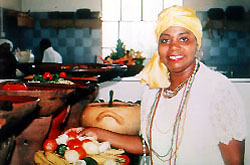
Bahia cooking
In this article, whose title is so rich in cooking metaphors
such as flavor, essence and secret, I intend to provide a
socio-anthropological account of the cuisine of Bahia
including, as well, conditioning aspects such as tourism,
which have led to what we dare calling the new cuisine of
Bahia. And just between us, all very secretly!
Guided by the different forms
of essence and secret, we will
unveil some aspects of the cuisine
of Bahia. But if it is a secret,
how can we get to know it? By
asking "What is so special about
Bahia women?" and "Have you
ever been to Bahia?" songwriter
Dorival Caymmi revealed some
secrets of Bahia that had been
kept under lock and key: our
women's clothing, our churches,
and even a "recipe-samba" that
teaches us how to make a good
vatapá (Afro-Brazilian dish of shrimp, fish or chicken with a
flour base, seasoned with coconut milk and African
palm oil):
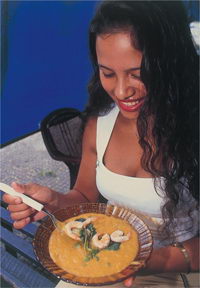
Vatapá
If you want vatapá – ô
Try to make it like so:
First add the corn meal,
Then the African palm oil,
Look for a black woman from
Bahia – ô
That can - stir
That can - stir
That can - stir
Add cashew nuts
A little bit more
Red pepper
A little bit more
Add peanuts, shrimp and grate
the coconut
Then mix it all together
Finally, season it with salt,
ginger and onions, Yayá!
The city of Salvador was
founded to meet the expanding
needs of the Portuguese mercantile
system and to serve as
the capital of Brazil for over two
centuries. The city became the
most important trading post in
the colony. Single-culture agriculture,
especially with sugarcane
in the Brazilian Northeast or
mineral extraction, formed significant
cycles in the exploitation of
the resources of the lands that
had been discovered.
This type of appropriation was
based on slave labor brought by the thousands from
several African regions. There was a time when the
city's black population was larger than that of white
people formed by the economic elites, the clergy,
administrators and poor white people.
Although
trading activities with Portugal were centered in
Salvador and the Recôncavo(vast and fertile coastal region of the state of Bahia), the colonialist
venture also penetrated the hot and humid regions
of the south as well as the vast region known as
the Hinterland, which is characterized by the
presence of caatingas (regions characterized by thorny, stunted vegetation), meadows, mountains,
and valleys.
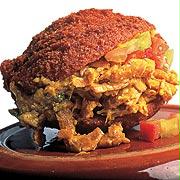
Acarajé
With a heterogeneous geographic and cultural
development, the hinterland is less populated and
still stigmatized by constant droughts. The
anthropologist and essay writer Antônio Risério,
who is also an observer of contemporary life in
Salvador, believes that the transfer of the colonial
capital to Rio de Janeiro, which was motivated by
political and economic factors, led the city to
isolation and to the development of an ethnically
diversified population, as well as a culture with a
specific historical configuration:
"For well over one hundred years, Bahia will
plunge into a period of relative isolation and
solitude, before its peripheral inclusion in the
northeastern expansion of Brazilian capitalism.
And the psychosocial tissue of a new culture,
which was organically born of the experiences
of the Portuguese people, of the Bantu people,
and of the Yoruba people – the latter sold, in
their majority, by the kings of Dahomey -
developed exactly from the ripening of these
more than one hundred years of isolation, of
nearly terrifying self-absorption. What we today
call the "culture of Bahia" is, therefore, a cultural
complex that can be historically dated. A
complex that is the full configuration of a process
that has unfolded since the 19th century."
It is no longer a secret the fact that the cuisine
of Bahia is diversified and that researchers complain
about the prevailing interest for the cuisine of the
capital and the Recôncavo, which is predominantly
marked by dishes of African origin or dishes
containing palm oil.
During the 20th Cultural
Meeting of Laranjeiras, held in the state of Sergipe,
in the mid-1990s, the Bahia-born folklore
researcher Hildegardes Vianna, in her "Breve
Notícia da Alimentação na Bahia" complains about
the lack of research "on the State's hinterland and
southern cuisine". She tries to fill in the gap by
presenting a short list of seafood dishes found in
the cuisine of the southern region of Bahia bathed
by the Atlantic Ocean: crab and fish dishes, and
westwards, in the border with the State of Minas
Gerais, meat and seafood dishes from the East
Coast.
The typical cuisine of the hinterland of Bahia,
in turn, is presented by Vianna as being sober and
a reflex of the poverty environment. In the basin of
the São Francisco river, the daily cuisine is marked
by the presence of manioc root flour and goat meat,
fresh beans and manioc mush, in which the flour is
scalded in milk, meat or fish broth.
The engineer and professor at the Engineering
School of the Federal University of Bahia, Guilherme
Radel has recently written the recipe book entitled
"A Cozinha sertaneja da Bahia".
The book reveals
secrets of the hinterland cuisine
and shows its evolution. In the
introduction, Radel's hinterland
cuisine is refined both in the
technique and in the ingredients,
although they can all be found in
the region. The author helps to
reveal the secret of the new
flavors and confirms the lack of
dissemination of other Bahia
dishes as well as the dictatorship
of the palm oil.
According to the
author "The hinterland cuisine
spreads throughout Bahia and its
presence is weaker exactly
where the presence of the Afro-
Bahia and Indigenous cuisines is stronger: in
Salvador, in the Recôncavo, and on the shore. In
the interior of Bahia, people eat basically the dishes
that are typical of hinterland cookery: beans; different
types of sun-dried meat dishes; sautéed, stewed,
and roasted goat, lamb and pork; meninico (stew made of mutton giblets); goat
or mutton haggis; pork giblets; sautéed and stewed
chicken; milk mush; mush made of corn meal;
pumpkin purée; cassava; pumpkin; maxixe (a type
of gherkin); fresh beans cooked in butter; goldenfried
manioc meal; and a dish made of goat and
golden-fried manioc meal.
Such is the structure of
hinterland cookery, which is undoubtedly the main
contribution to the cuisine of Bahia.
However, this very important aspect is not fairly
disseminated, thereby allowing the Afro-Bahia
cuisine to make up the so-called cuisine of Bahia,
as if the African people had been the only ones to
contribute to its development.
In the set of recipes recorded by the author
there are 362 different dishes made of goat, lamb,
pork, beef, poultry, eggs, fish, and game.
The secrets of religion are one of the elements
responsible for the frequent use of the muchcriticized
palm oil in hinterland cookery. The religious
syncretism of African origin extends, so to speak,
to hinterland cookery during the Passion Week.
Radel records 14 dishes containing palm oil in
hinterland cookery, which are included in the
category of food for occasions of "fasting and rules".
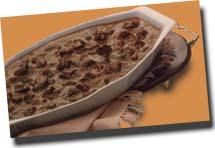
Sarapatel
The fixation of researchers with the Bahia
cuisine of African origin might be explained by
historical reasons. Something similar occurs with the
candomblé (religion of African origin brought to Brazil by African
slaves) brought to Bahia by the Yoruba
people to the detriment of the candomblé of Bantu
origin, among other groups of African matrices.
Particularly in Bahia, where the presence of
certain African groups could not be matched by any
other Brazilian region, cookery has been strongly
influenced by this interaction process that made up
the Brazilian society.
The strong presence, especially
of spices such as the palm oil, has contributed to
the development of the cooking system of the Bahia
cuisine. In his text entitled "Dietas Africanas", the
anthropologist Vivaldo da Costa Lima expressed the
methodological lines to understand the Afro-Bahia
cuisine, which has been mistakenly disseminated
as a homogeneous cooking system. According to
Costa Lima, the cuisine of Bahia is "The cuisine of a
whole geographic sub-region of Bahia known as
"Recôncavo".
The cuisine that developed in the
region – the Bahia cuisine – is also popularly known
as oil food, in an allusion to the palm oil, which is
extracted from the pulp of the fruit of the Elaesis
Guineensis palm tree.
Different types of pepper are "another constant
ingredient in Bahia cookery", especially the
Capsicum pepper, of the solanaceous family.
In his book entitled "A Bahia do Século XVIII",
Luís dos Santos Vilhena, a Greek professor who
lived in Bahia late in the 18th century, offers us a
menu of African dishes sold in the streets of
Salvador which, in Vilhena's view as a foreigner
are "despicable and insignificant":
"It is impossible not to notice eight, ten, and
even more black men and women coming out
of the wealthier houses in this city, where major
negotiations and deals are made, to sell in the
streets the most insignificant and despicable
things, such as different sorts of delicacies like
calf's foot, carurus (dish made with okra, fish, shrimp, chicken, peanuts,
cashew nuts, and seasoned with oil and peppers), vatapás, mingaus
(porridge), pamonha (cake made of green corn, cinnamon, etc., rolled and
cooked in cornhusks), canjica, i.e., corn
mush, acaçá (corn meal and rice flour mush),
acarajé (dish made with beans, seasoned with salt and onion,
fried in palm oil, and served with pepper sauce, dried
shrimp, vatapá, tomatoes, and green pepper), ubobó (dish made from beans, bananas, manioc, and
seasoned with palm oil), coconut rice, coconut
beans, angu (mush made of corn meal), and
the most shocking thing: dirty water mixed with
honey and other ingredients known as aloá,
which black people drink as lemonade."
The menu presented by Vilhena reveals trends
of a hybrid – although already Brazilian – Bahia
cuisine. These trends will be expressed mainly
among folklore researchers of regional-oriented
mind and sociologists.
In "Arte Culinária na Bahia" (Culinary Arts in Bahia) published late in
the 1920s, Manoel Querino expresses interest in
the "customs and habits of each region"; he
introduces Bahia cookery as a hybrid cuisine in
"the ethnical development of Brazil".
In the end of the 1930s, Sodré Vianna retired
to a voodoo center to copy 50 recipes of Bahia
cookery, which he later on published in his Xangô
Journal. The same author, in the text entitled
"Sauces of Bahia", published in the Anthology of
Food in Brazil and organized by Luís da Câmara
Cascudo, emphasizes the preference of the people
of Bahia for sauces especially prepared with red
pepper. In the same anthology, writer J. M. Cardoso
de Oliveira describes a dinner served in Bahia in
1889.
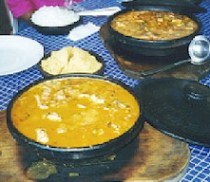
Muqueca
A history of passion filled with moquecas (broiled
fish), efó (vegetable paste with dried shrimp, palm
oil, red pepper and other spices), acarajé, abará
(dish made with beans, pepper and palm oil, and
rolled in banana leaves), acaçá (corn meal and rice
four mush)… Food is as much an element of the
house as its windows and residents. As Cardoso
de Oliveira wrote in his aforementioned book:
"On the window sills there was a line of bowls
of sweets. On the table, bowls of beaten eggs and
dough, and nutmeg and sugar clove packets lined
up. In the corner, Inacinha, although nauseated,
prepared the sponge cake, the coconut pudding,
the manuês (variety of corn cake made with honey);
in the kitchen the girls prepared the caruru made
of okra and leaves, sifted the flour for the vatapá,
cleaned the shrimps for the efó. In the grocery
stores on the same street, African women would
provide the abará, the acarajés and the aberéns
(baked cakes made of corn, sugar and water, and
rolled in banana leaves). D. Eugênia was in charge
of making the cassava cupcakes, the small milk
acaçás, and her two specialties: coconut and
cheese cupcakes and smoked bacon. But she
interfered everywhere, tasting something here,
adding butter there".
It is in the book entitled "História da Alimentação
no Brasil" (History of Food in Brazil) that Câmara Cascudo gives us one
of the most complete descriptions of Brazilian
cookery. He describes in detail the menu of cooking
techniques and the sociological aspects of the
Brazilian cuisine. Although he ate vatapá and caruru
in Salvador, at some of his colleagues' from the
medicine course, in 1918, he restricts these dishes,
in sociological terms, to the popular scope.
Sociologist Gilberto Freyre visited Bahia in the
1930s and was impressed with the politeness and
the cuisine of the people of Bahia, as he wrote in
the foreword of his "Casa Grande e Senzala".
Freyre, who was Franz Boas' student at Columbia
University, praised the sweets and
cakes prepared in the Brazilian
northeast, as recorded in the
book entitled "Açúcar". It is a
sociology of sweets, whose first
edition dates back to 1939.
The books by folklore writers
Hildegardes Vianna and Darwin
Brandão, which have the same name - "A cozinha
baiana" – describe the Afro-Bahia cuisine of Salvador
and the Recôncavo.
Roger Bastide, a French sociologist, was
particularly interested in palm oil dishes within the
context of the candomblé.
Costa Lima describes this cuisine in its religious
context and in the observation of its dynamics in
the secular context, as seen in the text entitled "Etnocenologia
– e etnoculinária – do acarajé". The author
of this article studied the Bahia cuisine of African
origin through a methodological approach that
adopts the perspective of the Training Restaurant
of Bahia cookery of the National Service of Commercial
Apprenticeship (SENAC).
The institution developed a six-month cooking
course on Bahia dishes aimed at the hotel-tourism
market. The course reflects the vicissitudes of its
organization and of the professional market in times
of globalization.
The dissemination of popular culture, particularly
of the Bahia cuisine of African origin, which
has been transformed into icons through delicacies
such as the acarajé, the abará, the vatapá, the
caruru and the shrimp bobó has contributed to the
development of important supramaterial conditions
in the rationalization of tourism: an image that
defines Bahia as a special and unique place for its
cuisine and the happiness of its people reinforce
these conditions. Writers and artists from Bahia are
the most important disseminators of this image that
was built in the historical and cultural process of
the daily lives of the people of Bahia.
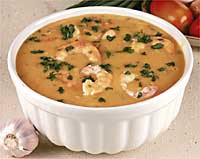
Bobó de Camarão
The mid-19th
century is the time limit when the image of Bahia
as the land that nourishes traditions was established.
Salvador, the state capital, is still proud of
its status as the "queen of the Atlantic", which has
been consolidated by its commercial position in
relation to the Southern Atlantic Ocean: "Europe,
France and Bahia" is an expression of the Brazilian
folklore, which was probably coined in the 19th
century and reveals the status of Bahia. An analogy
translated as something like Paris in relation to
Europe, and Bahia (Salvador or the city of Bahia) in
relation to the New World (America).
The secrets of the flavors of Bahia also imply
observing the movement of tradition and modernity.
As a result, we witness the emergence of new
cooks and the gastronomic and occupational
reinvention of the cuisine of Bahia. Many cooks
like D. Flor, a character in Jorge Amado's novel
"D. Flor e seus dois maridos" (D. Flor and her two
husbands), a book in which palm oil dishes color
the pages of the book golden yellow. Cooks like
Dadá, Alaíde, Dinha and Cira – all of whom are heirs
of the guardians of the practical know-how of the
cuisine of Bahia, old cooks of centuries-old families
or of the candomblé centers of Bahia. But they also
preserve tradition by including the new and
welcoming reinvention.
On the other hand, the Bahia cuisine of African
origin is being used by NGOs and community
institutions such as African groups during carnival
as a pedagogic element to bring education, selfesteem,
and citizenship especially to youths of
African origin; black organizations with strong
mobilization power set up cooking festivals to
entertain and preserve the memory and identity of
the cuisine of Bahia.
The African cuisine of Bahia therefore fulfills
its political role and wants more than just
reproducing the biological existence of its fans. The
food, although aimed at consumption, preserves
and renews the memory kept in taste, in the sound
of boiling palm oil, in the piquancy of the red pepper,
in the crispness of the acarajé. These secrets and
flavors are revealed to help strengthen and renew
humanity.
Back to Top